Sewage laying: how it is done
By and large, laying sewage in an apartment with their own hands is not much different from the same installation in the private sector, except that in the first option you do not need to dig trenches, as well as equip a cesspool or septic tank. In any room, pipes of this type and diameter serve the same purpose and require the same slope to optimize the flow.
Below we will review the basic requirements of editing, some nuances, and also show you the thematic video in this article.
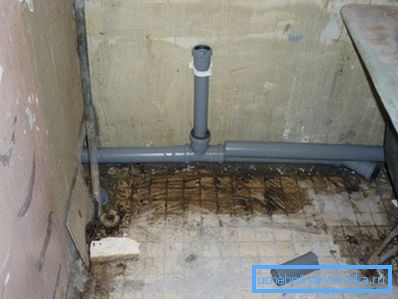
Sewer pipes
Materials
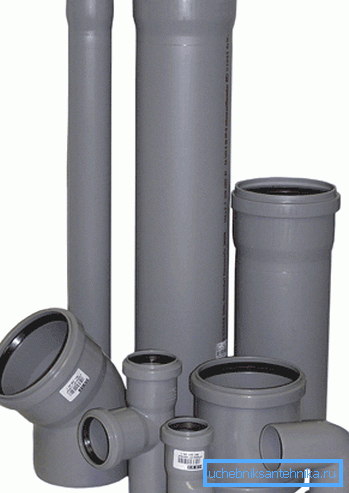
- Pipes with a diameter of 50 mm and 100 mm (for a washing machine and a dishwasher with a diameter of 32 mm) are used in the sewage distribution room, depending on the purpose. The 100-mm sections are usually standpipes and toilet liners, and the 50-mm sections are used for all other sanitary facilities.
- Fittings are used for decoupling knots, transitions to a different diameter, turns and frames of different nature. Therefore, such adapters can have a very different configuration, which allows you to go to another plane and do it at angles of 32?, 45? and 90 ?.

- Also, to switch from a cast-iron pipe to a plastic one, rubber reductions are used, which not only allow changing the diameter, but also serve as a good joint sealant.. Another reduction is used to switch from a 50-mm pipe to a 32-mm pipe, as well as corrugated siphon sleeves and a toilet bowl.
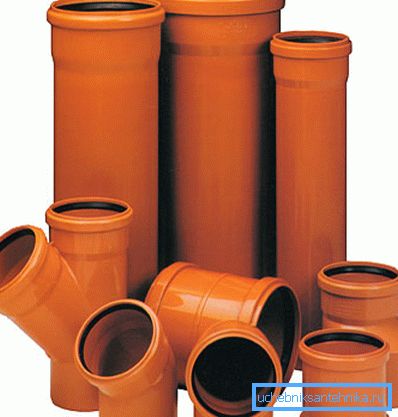
- But the laying of the external sewage system can be carried out both with 100-mm pipes and a large diameter of fragments, such as you see in the photo above - it all depends on the number of drains. Rubber reductions for large sections are not used - transitional and corrugated plastic sewer fittings are used for turning and changing the diameter. In the private sector, such material is used very rarely, it is used only for the common sewer line.
Note. In addition to the above materials for the arrangement of sewage also check valves and septic tanks are used, but this is a separate topic that requires special consideration. Of course, the price of such a project, like the materials themselves, will be much higher.
In the apartment

The apartment uses a trenchless method of laying sewage, that is, here almost all the wiring is carried out on the walls, on brackets - only pipes for a washing machine and a dishwasher with a diameter of 32 mm are mounted in the floor, and even then, not always.
All work in the apartment begins with the installation of the riser, but first you have to remove the old, cast iron and if such a replacement is not made on all floors, but in a single apartment, then you will have to do a sidebar.
To dismantle the riser in a single apartment, you need to cut out a piece of cast-iron pipe, but if you have a Bulgarian with a disc of 180 mm (the most common version), then its radius is not enough to cut a 100-mm pipe.
Therefore, you cut a piece with a height of 20-30 cm, leaving only the back wall, and after that you have access to the rear part, as the Bulgarian herself will enter the cut niche. After disconnecting all the horizontal wiring and completely removing this section, you gently loosen the pipe and remove it together (or separately) with the decoupling tee, but not to damage the glass of the lower pipe coming from the neighbors.

When you dismantle everything, you will need to clean the bottom glass of the seals (resin, cement) and cake to insert a rubber reduction, which will also serve as a sealant. And to move from the cast-iron end at the top (it also needs to be cleared of paint), use a special reducing plastic fitting (it can be seen in the photo).
When you insert into the lower reduction all the tees and quadruples you need (there may be more than one), then cut off the straight pipe fragment (without the glass) and insert it from the bottom, and calculate the mounting area in the upper plastic fitting so that the gap between the pipes no more than 5-7 cm. You will block this gap with a clutch that you need to put on either the top or bottom pipe, and then connect both ends to it.
Some people prefer to grease silicone under the rubber seal of the coupling, but this is not a prerequisite - the connection with the time is already sufficiently tightly coked and never passes the liquid.
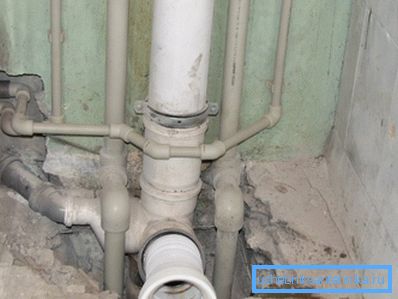
From the riser, the layout in the apartment is carried out by pipes with a diameter of 50 mm, the only exception is the variant with a displacement of the toilet bowl, then in the horizontal plane a 100-millimeter section is added. All pipes are mounted using plastic or metal brackets. The slope should be 1-2 cm per linear meter.
In the private sector
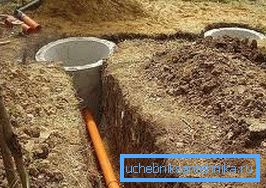
For the private sector, you need to bring the sewer to a septic tank or cesspool, and the trench width when laying the sewage system should be such as to provide access to the pipe itself. Naturally, the deeper you dig, the more space you need, therefore, a trench up to a meter deep is usually made two spit wide with a spade, and if deeper it is increased to three bayonets.
Leaving the house is laid under the foundation or through it - it depends on the depth, but in any case the route should be below the ground freezing point, even if you put the pipe in a case of mineral wool, polyurethane foam, penoizol or foamed polyethylene.
You can find out the level of freezing at the nearest weather station, or simply ask your neighbors who have already had to perform such work. Dig a trench 10 cm deeper than such a point, and you guarantee protection from frost.
Note. Some Internet users monitor the cost of laying sewage per meter, but such rates depend on the installation conditions, that is, trench depth, distance and so on are taken into account here, therefore, it is better to find out such data directly from the contractors.
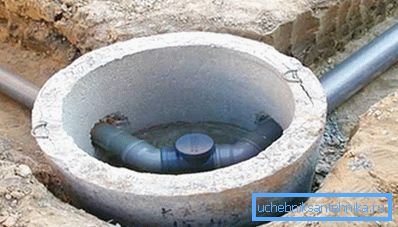
If the distance from the house to the septic tank is more than 4-5 meters, then it is best for you to equip an audit that you can embed in the well - it can be made from concrete rings, as shown in the photo above or from the brickwork. This will give you access to cleaning the pipe with a plumbing cable in the event of a sewer blockage.
Laying the pipe should be made on a sand cushion with a height of 20-30 mm, this will allow to observe the correct slope (1-2 cm per linear meter). They also cover the pipe with sand so that its layer is 40-50 mm higher than the level of the upper wall - this will protect the plastic from mechanical damage by stones, wire and other hard objects during the sediment.
So that the sand finally finally settles down, it should not be rammed, but poured abundantly with water with your own hands - after that you can immediately dump the soil into the trench.
Recommendation. When laying pipes, sharp turns should be avoided and even where there is a need to turn 90 ?, it is better to use two fittings of 45 ?. Such combinations reduce the possibility of blockage.
Conclusion
In conclusion, it can be said that laying sewers in a private house or apartment of a multi-storey structure does not pose any particular difficulties, since there are materials for this that are collected according to the principle of a children's designer. Nevertheless, it is very important to comply with all the conditions and rules of installation, which will ensure operation without problems and force majeure.